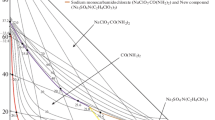Abstract
The critical temperature of KCl is estimated by a linear extrapolation of the molar free surface energy. Then the critical density is deduced from an extrapolation of the rectilinear diameter and the critical pressure from a linear extrapolation of the logarithm of the vapour pressure versus the reciprocal temperature. With the estimated data (T c =3000 K,P c =220 bar, ρc = 0.193 g cm−3) the reduced properties of KCl are investigated and compared with other substances. The largest deviation is in the behaviour of the reduced density: That of KCl near the triple point is larger than that of other substances by a factor of 2–3. This is caused mainly by the electrostriction in the ionic melt.
Zusammenfassung
Die kritische Temperatur von KCl wird auf Grund einer linearen Extrapolation der molaren freien Oberflächenenergie abgeschätzt. Dann folgt die kritische Dichte aus einer Extrapolation des geradlinigen Durchmessers und der kritische druck aus einer linearen Extrapolation des Logarithmus des Dampfdruckes gegen die reziproke Temperatur. Mit den abgeschätzten kritischen Daten (T c =3000 K,P c =220 bar, ρc = 0,193 g cm−3) werden die reduzierten Eigenschaften von KCl untersucht und mit anderen Substanzen verglichen. Die größte Abweichung tritt im Dichteverhalten auf: Die reduzierte Dichte von KCl in der Nähe des Tripelpunktes übersteigt die reduzierte Dichte anderer Substanzen um einen Faktor 2–3. Diese Besonderheit wird vor allem durch die Elektrostriktion in der Ionenschmelze verursacht.
Similar content being viewed by others
Literatur
E. A. Guggenheim, J. Chem. Physics13, 253 (1945);J. S. Rowlinson, Liquids and Liquid Mixtures, 2nd ed. London: Butterworth.1969.
F. Hensel undE. U. Franck, Rev. Mod. Phys.40, 697 (1968).
P. J. McGonigal, Temple Univ. 1964, Microfilm order no. 65-1410 from Ann Arbor, Mich.
Wegen einer besseren Näherung vgl.J. S. Rowlinson, Trans. Farad. Soc.50, 647 (1954).
M. Katayama, Sci. Rep. Tôhoku Imper. Univ.4, 373 (1916).
R. Eötvös, Wid. Ann.27, 456 (1886).
F. M. Jaeger, Z. anorg. allgem. Chem.101, 1 (1917).
E. R. van Artsdalen undI. S. Yaffe, J. Physic. Chem.59, 118 (1955).
H. Bloom, F. G. Davis undD. V. James, Trans. Farad. Soc.56, 1179 (1960).
J. S. Peake undM. R. Bothwell, J. Amer. Chem. Soc.76, 2653, 2656 (1954).
J. L. Barton undH. Bloom, J. Physic. Chem.60, 413 (1956).
Vgl.F. Kohler, Advances in Molecular Relaxation Processes (im Druck);F. Kohler, Structure of Liquids. Verlag Chemie (im Druck).
Die Eigenschaften für die anderen Substanzen sind den in zitierten Übersichten entnommen, sowieJ. Timmermans, Physico-Chemical Constants of Pure Organic Components, Vol. I und II, Elsevier 1950 und 1965, undK. A. Kobe undR. E. Lynn, Jr., Chem. Rev.52, 117 (1953).
J. O'M. Bockris undN. E. Richards, Proc. Roy. Soc. [London]241 A, 44 (1957).
A. L. Th. Moesveld undH. J. Hardon, Z. phys. Chem.A 155, 238 (1931).
A. Morabin undA. Tête, Rev. Gén. de l'Électricité77, 961 (1968).
L. G. Schornack undC. A. Eckert, J. Physic. Chem.74, 3014 (1970).
Author information
Authors and Affiliations
Additional information
Herrn Univ.-Prof. Dr.Matthias Pailer zum 60. Geburtstag gewidmet.
Mit 5 Abbildungen
Rights and permissions
About this article
Cite this article
Kohler, F. Zur Abschätzung der kritischen und reduzierten Eigenschaften von Kaliumchlorid. Monatshefte für Chemie 103, 685–694 (1972). https://doi.org/10.1007/BF00905429
Received:
Issue Date:
DOI: https://doi.org/10.1007/BF00905429




